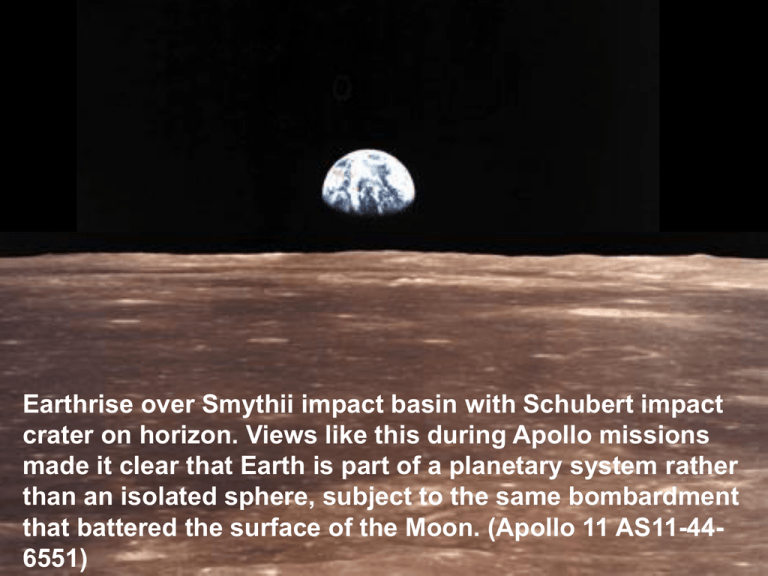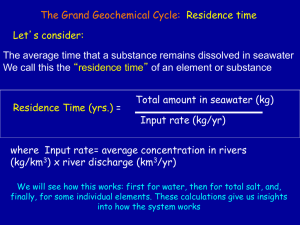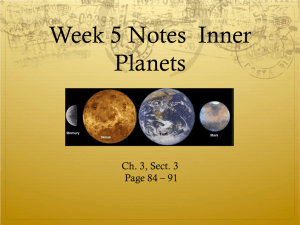Earth Venus and Mars
advertisement

Earthrise over Smythii impact basin with Schubert impact crater on horizon. Views like this during Apollo missions made it clear that Earth is part of a planetary system rather than an isolated sphere, subject to the same bombardment that battered the surface of the Moon. (Apollo 11 AS11-446551) Earth, the “Third Rock from Sun” is also called the “Lonely Planet” because, to our knowledge as yet, earth is the only planet with evidence of life and it is water that creates this uniqueness. This uniqueness comes from two cycles that define the Earth ... hydrological cycle; and plate tectonics. A conceptual look at the hydrological cycle. Notice its following peculiarities: 1. Evaporation exceeds precipitation over the oceans, but precipitation exceeds evaporation on land. 2. Currently, atmosphere transfers by precipitation all the water it receives by evaporation. 3. Run-off carries excess water as also rock materials from land to to oceans. Evaporation 60,000 km3 Evaporation 320,000 km3 Precipitation 285,000 km3 Ocean Storage 1,370,000,000 km3 Precipitation 3 Run-off: 95,000 km 35,000 km3 Hydrological Cycle and Global Warming ─ the Science of Climate Change Abundance Relative to Si = 106 H and O, the two elements that comprise the water molecule, are quite common. 12 10 108 104 100 10-4 0 20 40 60 Atomic Number Venus and Mars are Earth’s immediate neighbors and compositionally similar to the Earth. Mean Distance from Sun Mass Diameter Length of Day Length of Year Surface Gravity Venus Earth Mars 108.2 million km 0.815 AU 12,104 km 243 Earth days 225 Earth days 0.91 AU 149.6 million km 1 AU (5.974x1024 kg) 12,756 km 24 hours 365.2422 days 1 AU 228 million km 0.107 AU 6,794 km 24.6 Earth hours 687 Earth days 0.377 AU Earth is farther from the Sun compared to Venus, and Mars is still farther. The Atmospheres of Venus, Earth and Mars Venus Earth Mars Mean Surface Temperature 457° C 855° F 15° C 60° F -55° C -67° F Mean Surface Pressure 90 bars 1 bar 0.007 bars Mean density 5.204 gm/cm3 5.52 gm/cm3 3.933 gm/cm3 Major Gases 77% Nitrogen 96% Carbon 21% Oxygen Dioxide 3.5% Nitrogen 0.93% Argon ~ 1% water (varies) 95% Carbon Dioxide 2.7% Nitrogen 1.6% Argon 1.3% Oxygen http://www.planetary.org/saturn/atmos_compare.html Venus Thick atmosphere contains 96% CO2. Average temperature: 420°C Earth 0.03% of CO2 in the atmosphere. Average temperature: 15°C Mars Thin atmosphere (almost all CO2 in ground). Average temperature: -50°C Whole Universe Earth Hydrogen H 74.500 Helium He 23.840 Oxygen O Carbon C Nitrogen N Silicon Neon Magnesium Iron Sulphur Aluminum Calcium Nickel Sodium Argon Chromium Phosphorous Manganese Chlorine Potassium Other elements Si Ne Mg Fe S Al Ca Ni Na Ar Cr P Mn Cl K 0.8200 29.8 0.3750 0.0910 0.0830 0.0550 0.0570 0.1040 0.0380 0.0066 0.0074 0.0092 0.0033 0.0030 0.0032 0.0009 0.0011 0.0006 0.0003 15.6 13.9 33.3 1.5 1.8 2.0 0.2 1.9 The whole earth is richer in Fe, Mg and Ni, and poorer in Si, K and Al, than what is found on the earth’s surface. Crust Mantle Outer core Inner core Whole Earth density = 5.5 gm/cm3 Density of the crust = 2.7 gm/cm3 How about water on Mars? Mars is ... Earth Mars SiO2 45.1% 44.4% MgO 38.3% 30.2% FeO 7.8% 17.9% Al2O3 4.0% 3.0% CaO 3.5% 2.4% Cr2O3 0.5% 0.8% Na2O 0.3% 0.5% MnO TiO2 K2O 0.1% 0.5% 0.2% 0.1% 0.03% 0.04% Mars has two moons, Phobos and Deimos. compositionally similar to Earth; and appears to have once had water. The problem is that Mars ... lacks the atmosphere that would have enabled it to retain water; and no longer has the plate tectonics that the planet appears to have once had. This image is a map of Martian magnetic fields in the southern highlands. It is where magnetic stripes possibly resulting from crustal movement are most prominent. http://science.nasa.gov/newhome/headlines/ast29apr99_1.htm Some images of the Martian surface "Twin Peaks" on the horizon of the Mars Pathfinder landing site. Sunset on Mars An enhanced image of a Martian sunset as seen by the Sojourner rover in 1997. Without the run-off from land, ocean may eventually dry-up but that can occur only if water gets locked up in the atmosphere. Shouldn’t that foggy atmosphere then end up lowering the evaporation rate? Evaporation 320,000 km3 Evaporation 60,000 km3 Precipitation 95,000 km3 Precipitation 285,000 km3 Ocean Storage 1,370,000,000 km3 Run-off: 35,000 km3 The hydrological cycle is self-destructive The run-off from land also erodes the rocks and deposits this eroded material in the oceans, at the rate of ~15 billion metric tons per year. As the calculations alongside show, this should take no more than ~200 Ma to fill up the ocean basins. The run-off component of the hydrological cycle should thus eliminate the hydrological cycle in ~200 Ma. Time run-off needs to fill the ocean basins http://www.ngdc.noaa.gov/mgg/image/sedthick9.jpg The Wilson Cycle Solar heat received at the surface of Venus is about the same as that received on the Earth’s surface and on the surface of Mars. Expected Observed surface surface tempetemperature rature Relative distance from Sun Solar heat received... ... at the ... at the planetary planetary location surface Venus 0.72 AU ~2500 W/m2 ~650 W/m2 323°K 730°K Earth 1.00 AU ~1360 W/m2 ~680 W/m2 276°K 281°K Mars 1.52 AU ~ 600 W/m2 ~600 W/m2 215°K 215°K Therefore, distance from Sun is not the reason why Earth has abundance of water and Venus and Mars lack water. Temperature profiles of the atmospheres of Venus and Earth Major constituents of Seawater at 3.5% Salinity Constituent Water: Oxygen (O) Hydrogen (H) 85.8% 10.7% The most abundant ions Chloride (Cl-) Sodium (Na+) Sulfate (SO42-) Magnesium (Mg2+) Calcium (Ca2+) Potassium (K+) Bicarbonate (HCO3-) 1.9% 1.1% 0.3% 0.1% 0.04% 0.04% 0.01% only 2% of Cl in seawater could have come from land sources only 20% of sulfur in seawater could have come from land sources Annual volcanic output x Age of the Earth Estimated existing quantity 10,000 Quadrillion (1015) Metric Tons Water 1,000 100 10 Sulfur Chlorine Carbon Nitrogen 1 This comparison of the total quantities of selected substances in the oceans and atmosphere with what could have come from volcanism favors the volcanic origin of these substances. Adapted from Robert Decker & Barbara Decker: VOLCANOES (W.H. Freeman, New York, 1996) A trio of frames from Polar's Visible Imaging System (VIS), taken 6 seconds apart on December 31, 1998, captures an object rapidly descending toward northern Europe. Because the camera's filter isolates emission from hydroxyl (OH) radicals, the incoming object must have contained abundant water. The case for extraterrestrial origin of oceans Comets are >40% water. The deuterium/hydrogen ratio of comets and oceans overlap. Deuterium ratio Total Hydrogen Comet Halley 0.06-0.48 ppt Earth’s Oceans 0.16 ppt During the initial 2 Ga of its history, Earth may well have received 2 x 108 to 1 x 1017 metric tons of cometary matter by way of bombardment episodes. Comets may well have contributed significantly, therefore, to the hydrospheric mass of 1.4-1.7 x 1018 metric tons. Indeed, all this water could have been produced by either ~10% of the cometary mass or entirely by the asteroidal source if initial bombardment was of carbonaceous chondrites. Adapted from C.F. Chyba & C. Sagan in COMETS AND THE ORIGIN AND EVOLUTION OF LIFE (Ed: P.J. Thomas, C.F. Chyba & C.P. McKay; Springer-Verlag, New York, 1997). Suppose • annual influx from outer space is 50100 billion gallons of water vapor into the atmosphere, Compare this to the and that • this rate has been constant through geological history (~4.5 billion years). This amounts to 225450 x 1018 gallons of water. total amount of water in the oceans = 1370x106 Km3 (volume) 109 m3/Km3 264.2 gallons/m3 = 362 1018 gallons of water









